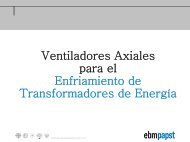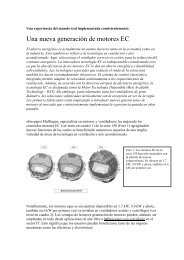Download [PDF] 2.3 MB - ebm-papst UK
Download [PDF] 2.3 MB - ebm-papst UK
Download [PDF] 2.3 MB - ebm-papst UK
Create successful ePaper yourself
Turn your PDF publications into a flip-book with our unique Google optimized e-Paper software.
DIFFUSER AXITOPFriction lossesInternal lossesand gap lossesExit losses PudFigure 1 (left): Power flow of an axialfan with unimpeded airflowFigure 3 (right): The AxiTop diffuserallows part of the dynamic pressureto be converted into useful staticpressure by retarding the flow.PressureConversionof dynamicpressure intoheatAir performance PuDrivepower PoLEGENDCustomer benefi tStaticoutput Pusp fp fsStart of diffuserEnd of diffuserp fd_cgesp fd_caxp fd_cuAxis of rotationFigure 2: The AxiTop diffuser from <strong>ebm</strong>-<strong>papst</strong>provides for a significant improvement ofefficiency and noise. Its pressure-boostingeffect minimises exit losses and makesit easier to adapt the fan to commerciallyavailable heat exchangers.is often no longer technically utilised. With theAxiTop diffuser, much of the dynamic kineticenergy is converted into static pressure (p fs ) byway of retardation. Physically, this is easy to explain:The total pressure generated (p f ) by a fanis the sum of the static pressure pfs and the dynamicpressure p fd_cges . In turn, taking the densityr into account, the dynamic pressure can be splitinto three speed components (cylinder coordinates),the axial component p fd_cax = /2*c ax² , thecircumferential component p fd_cu = /2*c u² andthe radial component p fd_cr = /2*c r² .In the diffuser, the axial and circumferentialcomponents of dynamic pressure (/2*c ges² ) arereduced due to the air slowing in the expandingcross section and, due to the conservation of energy(Bernoulli´s principle), the usable static pressurecomponent increases (see Fig. 3). Efficiencycan be significantly increased in this way if allcomponents are co-ordinated to be aerodynamicallyoptimised.In practice, the use of the AxiTop diffuserdoes not just mean lower energy consumption;it also means greater degrees of freedom for theuser and for the development engineer. The diffuserconfiguration can be optimised for differentcharacteristics, depending on the application concerned.Either a greater blower output is possiblewith unchanged energy input, or unchanged airperformance is possible with lower energy consumption.A diffuser can also greatly improve thenoise behaviour. This acoustic improvement isespecially interesting when fans are working is anoise-sensitive environment, for example in overnightoperation in ventilation and climate controlsystems in residential buildings or in rooms wherepeople meet and where there are also noise protectionregulations to be fulfilled.Significant potential to be exploited The potentialof the possible energy savings, increasedefficiency and noise reduction provided by an optimaldiffuser is substantial for common heat exchangerson the market. This has been confirmedin extensive test series. Figures 4a and 4b illustratea specific example. Replacing a normal fanwith a guard grille with the same fan with a supportbracket, guard grille and diffuser allows savingsof 27 % for energy consumption while enablingan operating noise level 7.2 dB(A) lower withthe same air flow (see Fig. 4a).Alternatively, if the greater efficiency of thefan with differ is exploited, it will deliver about 9 %more air flow with the same input power, and atthe same time noise emissions will be reduced by4.9 dB(A) (see fig. 4b). This value has been determinedon an exemplary customer application.Depending on the individual configuration, the optimisedefficiency can be used either to reducepower input or to increase air performance. So10techmag 01°2013


![Download [PDF] 2.3 MB - ebm-papst UK](https://img.yumpu.com/52907850/10/500x640/download-pdf-23-mb-ebm-papst-uk.jpg)



![[PDF] 22.3 MB - ebm-papst Argentina](https://img.yumpu.com/7645467/1/184x260/pdf-223-mb-ebm-papst-argentina.jpg?quality=85)